Purchasing in-office laboratory equipment is a long-term investment that requires careful research and planning. But, with so many options and features to choose from, where do you begin? “Start at the beginning,” says Michael Rothschild, O.D., founder of West Georgia Eye Care, in Carrollton, Ga. “Before you start deciding on equipment, decide what type of optical you want to have, what features you want to have and what’s important to you.”
For one practice, high-performance lenses and frames might be chief priorities, while another practice may focus on building relationships, so speed and expense are on the top of their list. “In our practice, we have a much higher profit margin by having an in-office lab because the cost of goods is much lower,” says Ellen Crothers, O.D., of Arbor Eye Center, in Austin. “Plus, it’s faster turnaround for our patients, so if they really want glasses that day, it saves them from walking out the door.”
Think about which features will help you best cater to your patients and set your practice apart from the competition. With the popularity of 8 base sunglasses and drill-mounted lenses, you might choose a system with grooving options for semi-rimless glasses, a polishing wheel and integrated drilling. “It’s not something a lot of offices have the capability to do, but it’s a real convenience and allows you to sell a more diverse inventory,” says Frank Crothers, A.B.O.C., office manager at the Arbor Eye Center.
You also want to think ahead—how will your purchase hold up one, five and 10 years down the line? Research the type of maintenance, upgrades and customer service the manufacturer offers. Many of today’s systems make self-maintenance easier; a trained lab technician can often perform the monthly calibrations, replace parts in house, and make basic repairs, saving you both time and money. Upgradeability also improves the longevity of your purchase and allows you to stay current with new trends, such as new drill mounts or the latest type of lenses.
Just as important as what you have in the machine, is who you have behind it. “If you don’t have a staff person who can properly edge the lenses, you’re going to lose a lot of money because you’re going to have re-makes,” Dr. Crothers says. With about 300 progressive lens designs on the market, it’s crucial that the technician knows what they’re working with so that the measurements are as precise as possible. By having a dedicated, skilled lab manager, you have a better hold on quality control.
Depending on the size of your office, you may want to cross-train other staff members so you have a back up in case of emergency. Cross training also helps to improve confidence and customer service in the optical. “Just about every pair of glasses you can sell, you can edge the lenses right there in your office,” Dr. Rothschild says. “If your optical staff is actually edging the lenses, they’ll be able to better guide the patient to match a frame to their prescription.”
Choosing whether to have an in-office lab can be a complex decision that entails a variety of different factors for different practices. But for some, it’s very simple. “In most full-service opticals, 60% of your income is going to come from the optical side—it just makes sense to be able to service that in-house,” Mr. Crothers says. “It’s a win-win situation for the patient, the staff and the doctor.”
Here’s a look at some of the latest in-office laboratory equipment:
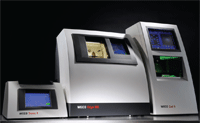 WECO Edge 580, AIT Industries
WECO Edge 580, AIT Industries
Distributed by AIT Industries, the WECO Edge 580 features integrated drilling and is designed to process wrap frames with ease. It can also produce Chemistrie Magnetic Sunlenses (Eyenavision), adding another source of revenue to increase profits. It has a grinding wheel for beveling all materials and a number of bevel programs, including automatic, program-guided, manual and flat. It can be used with the CAD 5 and Trace 3 to make tracing and blocking easier. The CAD 5 Autoblocker combines lensometry and blocking in one machine, while the Trace 3 delivers precise measurements on the most difficult-to-produce shapes.
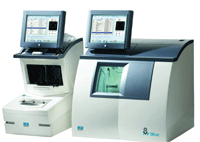 Mr Blue, Essilor Instruments
Mr Blue, Essilor Instruments
Essilor Instruments recently released Mr Blue, a sophisticated edging system that combines versatility and functionality. The system allows all jobs to be finished efficiently and safely—from simple standard work to super-hydrophobic AR to complex specialty shapes and fashionable wraps. It features automatic centering, auto-control of all finishes up to base 9 and a hybrid platform for wet and dry processes––including grooving, drilling and milling. Its unique milling capability prevents slippage of super-hydrophobic lenses and allows cutting of high-index lenses without an unpleasant smell. Users can keep their machines up to date with the built-in remote maintenance module, downloadable software upgrades and remote troubleshooting.
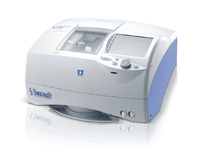
Me 1200 Lens Edger, Santinelli International
Distributed by Santinelli International, the Nidek Me 1200 Lens Edger boasts high-quality, step-beveling technology, allowing Rx lenses for any high-wrap frame. The unit also delivers high-curve beveling, partial beveling, partial grooving, design cut, faceting, advanced shape editing and 3-D grooving. It processes every possible type of three-piece mount, as well as Chemistrie Sunlenses using Click Mode software. The 8.4-inch color touch screen is user-friendly and displays shape and layout in full scale. An advanced polishing function eliminates knurl-mark edges, and the unit’s diamond grooving wheel allows for cleaner grooves. 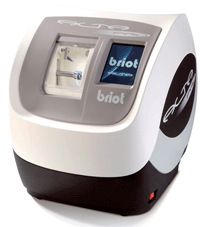
Alta Pro, Briot USA
With new software Briot recently released, users of the Alta Pro edger can now produce Chemistrie Magnetic Sunlenses. The software adds a menu item for Chemistrie, making it easy for the operator to align the placement of the magnets at the touch of a button. It will be standard on all new Alta Pro edgers, and current Alta Pro customers will be upgraded via BriotLink, Briot’s proprietary remote access service, or an on-site maintenance visit. It will allow Briot customers to produce custom-made sunlenses with a shape and base curve that matches the prescription lens, providing a better fit for patients.
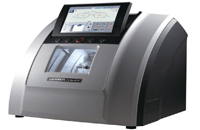 Excelon, Coburn Technologies
Excelon, Coburn Technologies
The new Excelon finishing line from Coburn Technologies features a range of customizable solutions—from high performance and fully functional to cost-effective and compact. All systems include intuitive control and graphical displays to guide you through the finishing process from beginning to end. There are 10 fully functional system combinations to choose from, which allows you to find a custom solution to best fit the needs and goals of your practice. Advanced 3-D digital technology is designed to reduce overall cycle time and cross-platform compatibility allows seamless workflow integration.
The Triplets, Essilor Instruments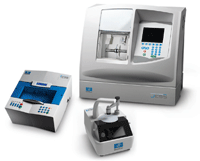
The Triplets from Essilor Instruments USA make up an integrated edging office system that includes a tracer, blocker and edger. The components can be configured to best meet your edging needs, but all are 3-D digital systems with dimension B down to 18mm for edging and polishing all materials. You can personalize your Triplets setup by increasing memory from 200 to 1,000 jobs and adding the shape modification option. Or you could also opt for the tracer touch screen that displays shapes on a 1:1 scale or select the variable grooving and safety beveling capability.
Real-Eyez, Santinelli International 
Santinelli recently introduced the Real-Eyez Profits Calculator, an interactive tool that calculates the costs and savings associated with finishing lenses in-office. The company says that calculations typically show how better purchasing and in-office finishing reduces outsourcing costs by as much as 30%. Their extensive team of sales consultants is fully trained on assessing practice needs and well qualified to advise on profit-building strategies. As a best practice, they provide this customized service to any practice at no cost.
Innovations, Ocuco Inc.
 Used by more than 3,000 labs worldwide, Ocuco’s Innovations lab management software now features a new, free-form module that interfaces with virtually all free-form LDSs and surfacing machines. This enables labs to transition into free-form lens manufacturing at an affordable price. Innovations automates prescription lens calculation, optimizes blank choice and manages the lens manufacturing process. This software is compatible with virtually all equipment from major suppliers, allowing your in-office lab to use equipment from different vendors in the same production line.
Used by more than 3,000 labs worldwide, Ocuco’s Innovations lab management software now features a new, free-form module that interfaces with virtually all free-form LDSs and surfacing machines. This enables labs to transition into free-form lens manufacturing at an affordable price. Innovations automates prescription lens calculation, optimizes blank choice and manages the lens manufacturing process. This software is compatible with virtually all equipment from major suppliers, allowing your in-office lab to use equipment from different vendors in the same production line.

